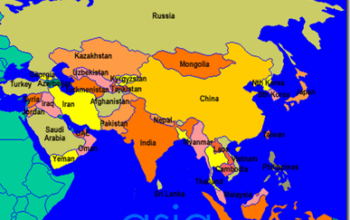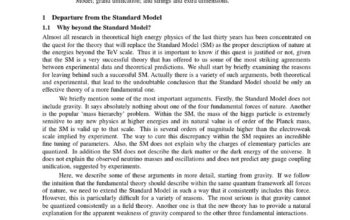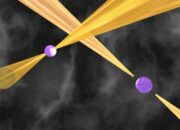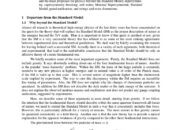The exploration of the universe, an endeavor characterized by a relentless pursuit of knowledge, has invariably come under scrutiny with respect to the prevailing theories that seek to elucidate its nature. Among these theories, the Standard Model of particle physics represents one of the most successful frameworks for understanding the fundamental particles and forces that constitute the universe. However, recent empirical investigations and theoretical advancements challenge the comprehensiveness of this model, indicating potential deficiencies that compel a reevaluation of our cosmic paradigm. This discourse will delineate the salient challenges to the Standard Model, engendered by both experimental anomalies and theoretical discordances, thereby fostering a nuanced understanding of the contemporary state of cosmological inquiry.
Initially, it is essential to elucidate what the Standard Model entails. This theoretical synthesis posits that the universe is fundamentally composed of fermions (matter particles) and bosons (force carriers), interconnected through a network of fundamental interactions: electromagnetic, weak nuclear, and strong nuclear forces. Yet, it remains conspicuously agnostic concerning gravity, a force that, while pivotal on a cosmic scale, resists straightforward incorporation within the framework. This oversight has prompted theorists to contemplate alternative models that synergize gravity with quantum mechanics, a venture beset by considerable complexities.
One pivotal challenge to the Standard Model emerges from the realm of neutrinos. These elusive particles, which are produced abundantly in stellar processes, have recently demonstrated an enigmatic property: they possess mass, contradicting the model’s initial stipulation of massless neutrinos. This revelation was propelled by multiple experiments, including those conducted at the Super-Kamiokande and the SNO (Sudbury Neutrino Observatory). The observation of neutrino oscillations, wherein neutrinos oscillate amongst three flavors, underscores a profound inconsistency, necessitating refinement or replacement of the Standard Model. The implications extend far beyond mere particle physics, inviting a reevaluation of our comprehension of mass and its genesis within the cosmos.
Furthermore, the conundrum of dark matter and dark energy remains a formidable hurdle that the Standard Model has yet to satisfactorily address. Astrophysical observations, such as the rotational velocities of galaxies and the cosmic microwave background radiation, provide compelling evidence for these constituents, which collectively comprise approximately 95% of the universe’s total energy density. However, their precise nature remains elusive. Various candidates for dark matter, including WIMPs (weakly interacting massive particles) and axions, have been proposed, yet no direct detection has materialized. Analogously, dark energy, hypothesized to account for the observed acceleration of cosmic expansion, challenges the conventional paradigms that the Standard Model offers. Its elucidation is imperative for a holistic understanding of the universe’s fate.
Moreover, the discrepancies observed in the behavior of muons and other particles have reinvigorated skepticism about the completeness of the Standard Model. The Muon g-2 experiment, which monitors the magnetic moment of muons, disclosed an anomaly that deviated from the predictions formulated by the Standard Model. Such deviations are tantalizing; they suggest the presence of phenomena or particles that lie beyond the established framework, potentially heralding a new era in particle physics that transcends the current limitations.
The implications of these challenges are manifold. They provoke a deep-seated inquiry into the very foundation upon which modern physics is built. In an academic milieu, the consensus is increasingly veering towards the pursuit of New Physics, an endeavor seeking theories that extend beyond the Standard Model. Candidates for such extensions include Supersymmetry, String Theory, and Quantum Gravity approaches, each positing novel concepts that endeavor to encapsulate both quantum phenomena and gravitational effects.
Moreover, the interpretation of quantum field theories and the philosophical ramifications of an incomplete model evoke rich discourse within scientific circles. What do these discrepancies imply about the nature of scientific truth? Are we, as a collective scientific community, on the precipice of paradigm shifts akin to those experienced during the transition from classical mechanics to quantum mechanics? Such questions not only highlight the complexities inherent in astronomical research but also illuminate the iterative nature of scientific progress, wherein theories are continually scrutinized, revised, or discarded in favor of more coherent explanations.
In examining the broader consequences of these theoretical inquiries, it becomes clear that such challenges do not merely resonate within the confines of theoretical physics; they reverberate with implications for cosmology, astrophysics, and even philosophy. As researchers endeavor to reconcile the dichotomy between established paradigms and anomalous phenomena, the quest for an amalgamated theory encapsulating the universe’s myriad complexities remains of paramount importance.
In conclusion, the scrutiny of the universe, framed within the context of challenges to the Standard Model, elucidates a vibrant landscape of inquiry and exploration. The emerging data necessitate a paradigm revisit that could redefine our understanding of the cosmos. As these challenges continue to be investigated through experimental and theoretical lenses, the aspiration to attain a coherent and unified theory—a grand theory of everything—remains one of the most ambitious endeavors of modern science. The cosmos, thus examined, is not merely a collection of objects and energies; it is a canvas upon which the curiosity of humanity paints its most profound explorations.












